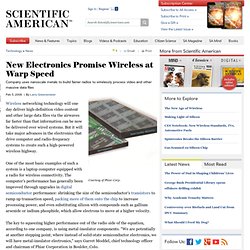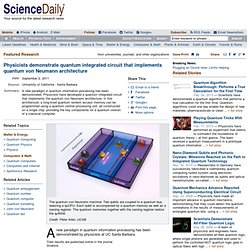

Electronic plastic. (PhysOrg.com) -- Plastic that conducts electricity holds promise for cheaper, thinner and more flexible electronics.
This technology is already available in some gadgets -- the new Sony walkman that was introduced earlier this summer and the Microsoft Zune HD music player released last week both incorporate organic light-emitting electronic displays. Until now, however, circuits built with organic materials have allowed only one type of charge to move through them. New research from the University of Washington makes charges flow both ways. The cover article in an upcoming issue of the journal Advanced Materials describes an approach to organic electronics that allows transport of both positive and negative charges.
"The organic semiconductors developed over the past 20 years have one important drawback. Co-authors are Felix Kim, a doctoral student working with Jenekhe, and graduate student Xugang Guo and assistant professor Mark Watson at the University of Kentucky. Robotics manufacture of electronics. By Bennett Brumson, Contributing Editor Robotic Industries Association Posted 07/07/2010 Robotics manufacturing electronic components and semiconductors have a long history.

As the trend towards ever smaller electronic devices continues along with the requirement for cleanliness, the need for robots will increase in these applications. The electronics within the robots performing tasks in semiconductor and electronic applications mirrors the trends toward becoming smaller and more powerful. Robotics used for manufacturing electronics and semiconductors are becoming smaller and more powerful. “High speed and precision are critical for electronic testing. DENSO Robotics (Long Beach, California). Changing to Delta To meet high speed and precision requirements of manufacturing semiconductors and electronics, integrators are increasingly advising end-users to invest in delta-style robots, contends Garry Sperrick, Sales Manager with Progressive Machine and Design, LLC (PMD, Victor, New York).
Wireless at Warp Speed. Wireless networking technology will one day deliver high-definition video content and other large data files via the airwaves far faster than that information can be now be delivered over wired systems.

But it will take major advances in the electronics that drive computer and radio-frequency systems to create such a high-powered wireless highway. One of the most basic examples of such a system is a laptop computer equipped with a radio for wireless connectivity. The computer's performance has generally been improved through upgrades in digital semiconductor performance: shrinking the size of the semiconductor's transistors to ramp up transaction speed, packing more of them onto the chip to increase processing power, and even substituting silicon with compounds such as gallium arsenide or indium phosphide, which allow electrons to move at a higher velocity.
"We're bridging the performance between photonics and electronics," says Adam Rentschler, Phiar's director of business development. Piezotronics - nanobot electronics. Breakthrough toward quantum computing. A sort of Holy Grail for physicists and information scientists is the quantum computer. Such a computer, operating on the highly complex principles of quantum mechanics, would be capable of performing specific calculations with capabilities far beyond even the most advanced modern supercomputers.
It could be used for breaking computer security codes as well as for incredibly detailed, data-heavy simulations of quantum systems. It could be used for applying precise principles of physics to understanding the minute details of the interactions of molecules in biological systems. It could also help physicists unravel some of the biggest mysteries of the workings of the universe by providing a way to possibly test quantum mechanics. Such a computer exists in theory, but it does not exist in practicality – yet – as it would need to operate with circuitry at the scale of single atoms, which is still a daunting challenge, even to state-of-the-art experimental quantum science. Physicists demonstrate quantum integrated circuit that implements quantum von Neumann architecture.
A new paradigm in quantum information processing has been demonstrated by physicists at UC Santa Barbara.

Their results are published online in the journal Science. The UCSB physicists have developed a quantum integrated circuit that implements the quantum von Neumann architecture. In this architecture, a long-lived quantum random access memory can be programmed using a quantum central processing unit, all constructed on a single chip, providing the key components for a quantum version of a classical computer. The UCSB hardware is based on superconducting quantum circuits, and must be cooled to very low temperatures to display quantum behavior. The architecture represents a new paradigm in quantum information processing, and shows that quantum large-scale-integration is within reach.